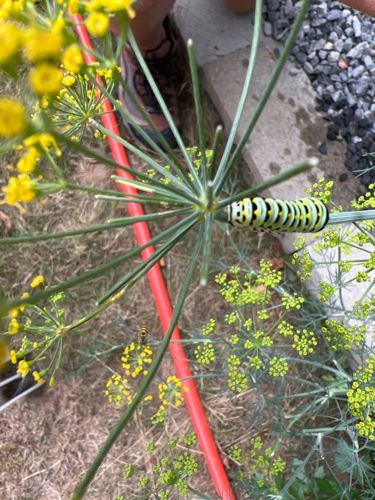Black Swallowtail Caterpillar
Scientific Name: Papilio polyxenes
Order & Family: Order: Lepidoptera, Family: Papilionidae
Size: Caterpillars can grow up to 2 inches (5 cm) in length. Adult butterflies have a wingspan of 3.1 to 4.1 inches (7.9 to 10.4 cm).

Natural Habitat
Black Swallowtail caterpillars are commonly found in gardens, meadows, open fields, and disturbed areas where their host plants grow. They are often seen in home gardens due to the cultivation of their preferred food sources like dill, parsley, and fennel. Adult butterflies can be found in similar open, sunny habitats where they can find nectar sources.
Diet & Feeding
In their larval (caterpillar) stage, Black Swallowtails are herbivores, primarily feeding on plants in the carrot family (Apiaceae). This includes herbs such as dill (as seen in the image), parsley, fennel, and rue, as well as vegetables like carrots and celery. Adult Black Swallowtail butterflies feed on nectar from a wide variety of flowering plants.
Behavior Patterns
As caterpillars, they feed voraciously on host plants to prepare for pupation. They can be found in various instars, with the early instars being dark colored and camouflaged as bird droppings, while later instars (like the one pictured) are green with black and yellow markings. When threatened, they can evert an osmeterium, a Y-shaped orange organ from behind their head, which releases a foul-smelling odor to deter predators. After pupating into a chrysalis, they emerge as beautiful black swallowtail butterflies. The adult butterflies are active during the day, nectaring on a variety of flowers and laying eggs on host plants.
Risks & Benefits
Potential Risks: For home gardeners, a large infestation of black swallowtail caterpillars can cause significant defoliation of host plants, particularly if they are young or small plants intended for consumption. However, this is generally minor and temporary damage. Potential Benefits: As adults, Black Swallowtail butterflies are important pollinators, contributing to the reproduction of many flowering plants. Their caterpillars are also a food source for various birds and other insect predators, playing a role in the food chain. They are a beloved and iconic species due to their beauty and intricate life cycle, often serving as an educational tool for children and adults interested in entomology and gardening.
Identified on: 8/19/2025